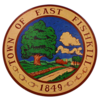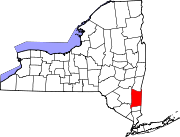East Fishkill, New York
East Fishkill, New York | |
|---|---|
 Town hall, on NY Route 376 south of Hopewell Junction | |
 Location of East Fishkill, New York | |
| Coordinates: 41°34′N 73°48′W / 41.567°N 73.800°W | |
| Country | United States |
| State | New York |
| County | Dutchess |
| Established | 1849 |
| Government | |
| • Type | Town Council |
| • Town Supervisor | Nicholas D'Alessandro (R) |
| • Town Council | List |
| Area | |
• Total | 57.39 sq mi (148.63 km2) |
| • Land | 56.50 sq mi (146.35 km2) |
| • Water | 0.88 sq mi (2.29 km2) |
| Elevation | 289 ft (88 m) |
| Population (2010) | |
• Total | 29,029 |
| • Density | 521.01/sq mi (201.16/km2) |
| Time zone | UTC-5 (Eastern (EST)) |
| • Summer (DST) | UTC-4 (EDT) |
| ZIP Codes | 12533, 12590, 12582 (There is no ZIP for East Fishkill. USPS addressing is split between Hopewell Junction, Stormville and Wappingers Falls) |
| Area code | 845 |
| FIPS code | 36-027-21996 |
| GNIS feature ID | 0978917[2] |
| Website | eastfishkillny |
East Fishkill is a town on the southern border of Dutchess County, New York, United States. The population was 29,707 at the 2020 census.[3] Until its creation in 1849, the town was the eastern portion of the town of Fishkill.
Hudson Valley Research Park is located in the town. The site once known as IBM East Fishkill, once housed 27 divisions and 4,700 regular employees for IBM Microelectronics, which later became a part of GlobalFoundries. IBM produced microchips at this facility and it also house the advanced, automated processor fabrication facility where IBM's "Cell" processor was co-developed. The fab's current owner is Onsemi.
History
[edit]
The Wiccopee, a sub-tribe of the Wappinger Native Americans, once lived in what is now the East Fishkill hamlet of Wiccopee.[4] One early European settler arrived around 1759.
Platt Rogers Spencer, the inventor of the leading U.S. business-handwriting style of the 19th Century, was born in the area in 1800.
The town of East Fishkill was established in 1849 from the eastern part of the town of Fishkill. Its name comes from Fishkill Creek, known as the Vis Kille (Fish Creek) to the Dutch settlers in the area.[5]
Geography
[edit]According to the United States Census Bureau, the town has a total area of 57.4 square miles (148.6 km2), of which 56.5 square miles (146.3 km2) is land and 0.89 square miles (2.3 km2), or 1.54%, is water.[6]
East Fishkill is bordered on the west by Fishkill and Wappinger, on the north by LaGrange, and on the east by Beekman and Pawling. The southern town line borders Philipstown and Kent, both of which are part of Putnam County.
Interstate 84 and the Appalachian Trail pass across the town. The Taconic State Parkway runs north–south as well.
Climate
[edit]According to the Köppen Climate Classification system, East Fishkill has a hot-summer humid continental climate, abbreviated "Dfa" on climate maps. The hottest temperature recorded in East Fishkill was 101 °F (38.3 °C) on August 9, 2001, while the coldest temperature recorded was −22 °F (−30.0 °C) on January 27, 1994.[7]
| Climate data for Stormville, New York, 1991–2020 normals, extremes 1990–2007 | |||||||||||||
|---|---|---|---|---|---|---|---|---|---|---|---|---|---|
| Month | Jan | Feb | Mar | Apr | May | Jun | Jul | Aug | Sep | Oct | Nov | Dec | Year |
| Record high °F (°C) | 67 (19) |
68 (20) |
90 (32) |
95 (35) |
96 (36) |
93 (34) |
100 (38) |
101 (38) |
92 (33) |
85 (29) |
77 (25) |
71 (22) |
101 (38) |
| Mean daily maximum °F (°C) | 35.4 (1.9) |
38.9 (3.8) |
48.6 (9.2) |
61.4 (16.3) |
71.7 (22.1) |
77.1 (25.1) |
83.1 (28.4) |
81.8 (27.7) |
74.3 (23.5) |
62.8 (17.1) |
50.4 (10.2) |
39.3 (4.1) |
60.4 (15.8) |
| Daily mean °F (°C) | 26.2 (−3.2) |
29.0 (−1.7) |
37.6 (3.1) |
49.5 (9.7) |
60.1 (15.6) |
67.4 (19.7) |
73.0 (22.8) |
71.9 (22.2) |
64.4 (18.0) |
53.0 (11.7) |
41.3 (5.2) |
31.5 (−0.3) |
50.4 (10.2) |
| Mean daily minimum °F (°C) | 17.0 (−8.3) |
19.1 (−7.2) |
26.6 (−3.0) |
37.5 (3.1) |
48.5 (9.2) |
57.7 (14.3) |
63.0 (17.2) |
62.0 (16.7) |
54.5 (12.5) |
43.2 (6.2) |
32.3 (0.2) |
23.6 (−4.7) |
40.4 (4.7) |
| Record low °F (°C) | −22 (−30) |
−11 (−24) |
−2 (−19) |
15 (−9) |
31 (−1) |
40 (4) |
47 (8) |
46 (8) |
32 (0) |
26 (−3) |
11 (−12) |
−1 (−18) |
−22 (−30) |
| Average precipitation inches (mm) | 3.72 (94) |
3.42 (87) |
3.95 (100) |
3.82 (97) |
3.62 (92) |
4.48 (114) |
4.36 (111) |
3.75 (95) |
5.07 (129) |
4.71 (120) |
3.90 (99) |
4.14 (105) |
48.94 (1,243) |
| Average snowfall inches (cm) | 14.3 (36) |
12.9 (33) |
14.3 (36) |
3.1 (7.9) |
0.0 (0.0) |
0.0 (0.0) |
0.0 (0.0) |
0.0 (0.0) |
0.0 (0.0) |
0.0 (0.0) |
2.1 (5.3) |
11.2 (28) |
57.9 (146.2) |
| Average precipitation days (≥ 0.01 in) | 13.0 | 9.9 | 12.7 | 12.5 | 12.5 | 11.4 | 10.6 | 10.3 | 10.1 | 9.2 | 10.6 | 11.1 | 133.9 |
| Average snowy days (≥ 0.1 in) | 8.7 | 5.9 | 5.6 | 1.3 | 0.0 | 0.0 | 0.0 | 0.0 | 0.0 | 0.1 | 1.4 | 5.2 | 28.2 |
| Source 1: NOAA[8] | |||||||||||||
| Source 2: XMACIS2[7] | |||||||||||||
Demographics
[edit]| Census | Pop. | Note | %± |
|---|---|---|---|
| 1850 | 2,610 | — | |
| 1860 | 2,544 | −2.5% | |
| 1870 | 2,305 | −9.4% | |
| 1880 | 2,574 | 11.7% | |
| 1890 | 2,175 | −15.5% | |
| 1900 | 1,970 | −9.4% | |
| 1910 | 2,226 | 13.0% | |
| 1920 | 1,944 | −12.7% | |
| 1930 | 1,845 | −5.1% | |
| 1940 | 2,024 | 9.7% | |
| 1950 | 2,565 | 26.7% | |
| 1960 | 4,778 | 86.3% | |
| 1970 | 11,092 | 132.1% | |
| 1980 | 18,091 | 63.1% | |
| 1990 | 22,101 | 22.2% | |
| 2000 | 25,589 | 15.8% | |
| 2010 | 29,029 | 13.4% | |
| 2020 | 29,707 | 2.3% | |
| U.S. Decennial Census[9] | |||
As of the census of 2000, there were 25,589 people, 8,233 households, and 7,006 families residing in the town. The population density was 449.7 inhabitants per square mile (173.6/km2). There were 8,495 housing units at an average density of 149.3 per square mile (57.6/km2). The racial makeup of the town was 92.54% white, 2.29% African American, 0.15% Native American, 2.8% Asian, 0.02% Pacific Islander, .86% from other races, and 1.34% from two or more races. Hispanic or Latino of any race were 4.04% of the population.
There were 8,233 households, out of which 45.8% had children under the age of 18 living with them, 75.7% were married couples living together, 6.5% had a female householder with no husband present, and 14.9% were non-families. Of all households 11.9% were made up of individuals, and 3.9% had someone living alone who was 65 years of age or older. The average household size was 3.10 and the average family size was 3.38.
In the town, the population was spread out, with 29.7% under the age of 18, 6.4% from 18 to 24, 30.4% from 25 to 44, 25.5% from 45 to 64, and 8.0% who were 65 years of age or older. The median age was 37 years. For every 100 females, there were 98.9 males. For every 100 females age 18 and over, there were 96.9 males.
The mean income for a household in the town was $116,059, and the mean income for a family was $129,660.[10] Males had a median income of $59,735 versus $35,014 for females. The per capita income for the town was $28,553. About 1.5% of families and 2.8% of the population were below the poverty line, including 2.7% of those under age 18 and 3.7% of those age 65 or over.
Locations
[edit]- Fishkill Plains – A hamlet in the northwestern part of the town.
- Gayhead – A location just outside of Hopewell Junction.
- Hillside Lake – A location northeast of Fishkill Plains.
- Hopewell Junction – A hamlet in the northwestern part of the town.
- Hortontown – A hamlet in the eastern section of town.
- Leetown - An area on top of Stormville Mountain, named after early settlers.
- Lomala – A hamlet south of Hopewell Junction.
- Pecksville – A hamlet in the southeastern corner of the town.
- Shenandoah – or Shenandoah Corners – A hamlet in the southern part of the town, near Interstate 84, the Taconic State Parkway, and the Appalachian Trail. The former Shenandoah Service Area on the Taconic Parkway is named for this community.
- Stormville – A hamlet in the eastern part of the town named after early settlers, brothers Jacob and Rupert Storm.
- Wiccopee (was Johnsville c. 1800–1904) – A hamlet near the western town line. It includes the area of Fishkill Hook.[11][12]
See also
[edit] Hudson Valley portal
Hudson Valley portal- 2 M6 cars (9030 and 9031) were donated to the MTA K9 Police Training Center and Connecticut Air National Guard, which is in Stormville.
References
[edit]- ^ "2016 U.S. Gazetteer Files". United States Census Bureau. Retrieved July 4, 2017.
- ^ a b U.S. Geological Survey Geographic Names Information System: East Fishkill, New York
- ^ United States Census Bureau, 2020 Report, East Fishkill town, New York
- ^ Mills, Malcolm J. (2006). East Fishkill. Arcadia. p. 47. ISBN 978-0-7385-4460-1.
The Wiccopee were a subtribe of the Wappinger Indians and had villages at Fishkill Hook and on the flat land near Fishkill.
- ^ Hooper Shelton. "Fisher County". Texas State Historical Association. Retrieved May 24, 2012.
- ^ "Geographic Identifiers: 2010 Demographic Profile Data (G001): East Fishkill town, Dutchess County, New York". U.S. Census Bureau, American Factfinder. Archived from the original on February 13, 2020. Retrieved November 12, 2015.
- ^ a b "xmACIS2". National Oceanic and Atmospheric Administration. Retrieved June 13, 2024.
- ^ "U.S. Climate Normals Quick Access – Station: Stormville, NY". National Oceanic and Atmospheric Administration. Retrieved June 13, 2024.
- ^ "Census of Population and Housing". Census.gov. Retrieved June 4, 2015.
- ^ "Archived copy". Archived from the original on April 5, 2019. Retrieved March 17, 2013.
{{cite web}}: CS1 maint: archived copy as title (link) - ^ Koehler, Linda (1994). Dutchess County, NY Churches and Their Records. Kinship. p. 57. ISBN 978-1-56012-133-6.
There were only 2 homes in the area of Fishkill Hook (Wiccopee) in the south west corner of the Town of Fishkill in 1794. The hamlet that grew up in the area was called Johnsville from about 1800, but resumed the name Wiccopee in 1904.
- ^ Wyck, Richard T. Van (1997). A War to Petrify the Heart. Black Dome Press. p. 70. ISBN 978-1-883789-12-1.
Fishkill Hook, a farming area, including the hamlet of Johnsville (now Wiccopee)


